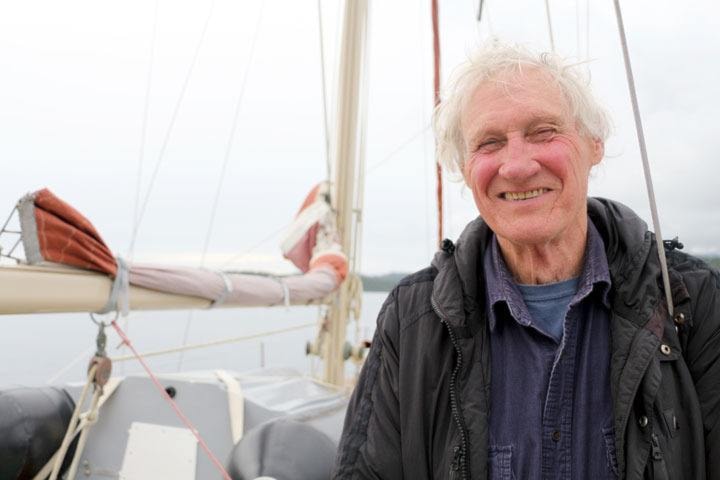From one edge of the Arctic Circle to the other, it took Michael Johnson on his 44 foot-schooner two years to cross the Northwest Passage, and last week he anchored in Prince Rupert along the final stretch of his four-year voyage.
The Gitana tied up at the Prince Rupert Rowing and Yacht Club on Sept. 1 and the storied captain took the time to pull out a map and describe his journey in his soft southern drawl. Johnson left Chesapeake Bay in Maryland in the Gitana in the spring of 2013 and headed north.
The first person to sail the Northwest Passage was the Norwegian explorer Roald Amundsen from 1903-1906. Few ships were successful in the crossing after Amundsen until after 2007 when the route was more accessible to ships without needing an icebreaker. However, Johnson said it’s a misconception that climate change means less ice along the passage. There is less multi-era ice but seasonal ice still fluctuates and Johnson and his crew had a tough first year.
“It turned out that 2013 was actually a very heavy ice year, which was the year we got up there. In fact, I talked to a barge captain up there and he said he hasn’t seen ice like that up there in 20 years,” Johnson said.
There was a dramatic increase of sea ice in 2013, with 5.1 million square kilometres of Arctic sea ice compared with 3.41 million square kilometres in 2012, according to the National Snow and Ice Data Center. When the Gitana reached Pond Inlet, Nunavut, they encountered several boats turning back to Greenland due to the ice.
“We persevered and moved on and said we’ll go as far as we can,” he said. The RCMP stationed at Pond Inlet cleared Johnson and the crew through customs and for an added treat, Johnson said the Mounties allowed the crew to use the vacant jail to take a shower and wash their clothes.
They continued on and sailed through Lancaster Sound, then went down Prince Regent Inlet and then attempted to mimic Amundsen’s route through Peel Sound — but the ice didn’t open up in 2013. Instead, they squeezed through Bellot Strait where the ice door closed right behind them as the schooner went through.
 Once they got to Cambridge Bay, Nunavut, they pulled the boat out of the water and flew back to the U.S. until the ice melted and the route opened up the following year. Johnson thought he had removed most of the glass on the boat, but when he returned in 2014, he found a bottle of hot sauce, with the sauce standing upright and the glass shattered around the base.
Once they got to Cambridge Bay, Nunavut, they pulled the boat out of the water and flew back to the U.S. until the ice melted and the route opened up the following year. Johnson thought he had removed most of the glass on the boat, but when he returned in 2014, he found a bottle of hot sauce, with the sauce standing upright and the glass shattered around the base.
“It was that cold. Some of my Inuit friends told me it was -67 Fahrenheit,” he said.
He also encountered the research vessel, the Martin Bergmann, one of the ships involved with the Franklin expedition. After Johnson left he heard that the Canadian archaeologists had found the HMS Erebus, one of the two ships that left England in 1845 to explore the Northwest Passage and never returned.
“The Canadians have quite a big operation going in Cambridge Bay. I think they’re bolstering their presence in the Arctic with their claims and counter claims,” Johnson said.
As the Gitana pressed on, the weather took a turn late in the 2014 season but they were fortunate to maneuver their way through the Bering Strait to Nome, Alaska, where they completed the Northwest Passage — the 87th sailing vessel to do so, according the Scott Polar Institute. With the passage complete, the crew used a construction crane to pull the boat out of the water in Nome and left it there for the winter.
In 2015, Johnson and a new crew went down Dutch Harbour and sailed around the Aleutians to Kodiak Island where they wintered the boat. This year, Johnson went from Alaska, to Prince Rupert, where he took a few days to enjoy the area, and then he left for Haida Gwaii.
Johnson wanted to take a couple of years to explore the communities he passed by. Doing the whole voyage in one year might have been possible, sea ice depending, but he wanted to meet the people who live there. In 40 years of sailing, Johnson has been all over the world but this recent voyage has been a highlight.
“One thing I’d like to say is that everyone up there in the Canadian, Alaskan and Greenland arctic, they all treated us just great. I think because there are so few people up there,” he said.
This year, he received the Ocean Cruising Club’s Barton Cup for completing the Northwest Passage. It was the second time he received the cup, a feat only two others have accomplished. The first time he received the Barton Cup was for going east to west around Cape Horn in 85 days without engine power in 1990.
Johnson plans to end his four year journey from one coast to another in Seattle by October.
